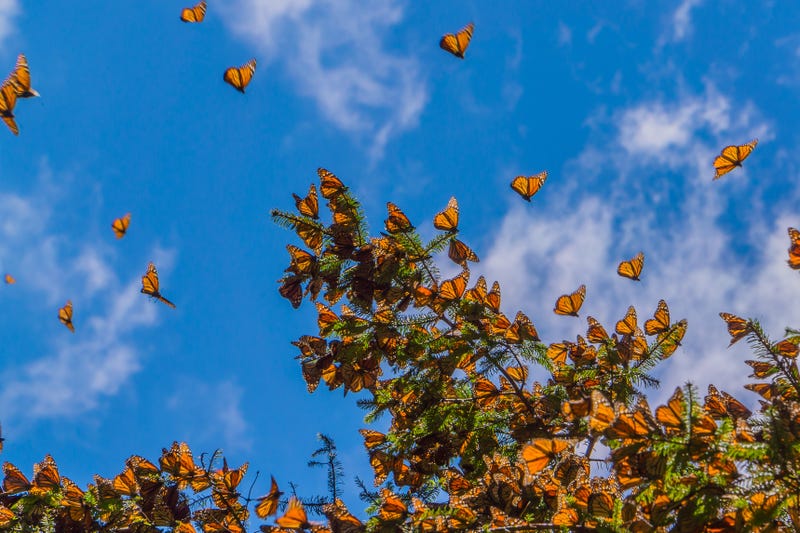
Monarch butterflies are one of the most well-known species of butterfly, but sightings of them can be rare. Right now in Louisiana may be your window to check them out.
As the butterflies follow their migration pattern south to Mexico, monarch butterflies will be making their annual autumn appearance in Louisiana. The Louisiana coast is particularly inviting territory for the monarchs because their food of choice, the native milkweed, grows along the Louisiana coast.
Zack Lemann, an entomologist with the Audubon Butterfly Garden and Insectarium, says not to worry about the caterpillars being harmful to your garden. The monarch caterpillar is a very picky eater. “The only thing the monarch caterpillar will eat is the milkweed plant. That is all it will eat,” Lemann emphasizes.
He also notes that the monarch is a federally protected species that seems to be universally beloved … and if you want them to flourish, you first have to feed them. “I always tell butterfly enthusiasts that if you want to help butterflies, then it’s a great idea to plant things that caterpillars eat. I know it’s a bit weird to walk into a garden center and say ‘I want to plant something and I sure do hope it all gets eaten up’, but that’s an important thing to do if you want to foster this species,” Lemann adds.
“Many of us have tropical milkweed in our gardens here in Louisiana. It’s the milkweed that is the easiest to grow and one that most nurseries provide. For the past ten years or so, we encourage people in the gulf states to cut back on the milkweed on the 1st of November. That plant should be up and available in the spring time here. If monarchs flying north from Mexico find milkweed here in March, April, and May, that’s the best thing we can do for them,” nots Lemann.
While everyone is familiar with the iconic orange and black wings of the monarch butterfly, Lemann is quick to point out that before the butterfly comes the caterpillar, and that’s the stage where protecting monarchs is most crucial. “Before you can protect the butterfly, you have to protect what comes first: the caterpillar! The monarch caterpillar starts off small. Its first meal is actually the egg that it hatches out of. After that, the only thing the monarch caterpillar will eat is the native milkweed plant,” Lemann illustrates.
This means you shouldn’t worry about the monarch caterpillar chewing up the leaves and flowers you value. They are specialists who will only eat the milkweed plant, so you won’t be losing your prized petunias if you see monarch caterpillars in your backyard. “Leaving them alone is usually the move to make,” Lemann adds. “The main thing that will kill them is if they get wet, and then there’s a freezing event.” This means you’ll want to avoid watering your garden before a temperature drop (something you generally should avoid anyway) in order to keep the caterpillars from dying off during the temperature change. “They can survive the temperature drop itself. It’s getting wet during it that kills them,” Lemann points out.
The feds are trying to protect monarchs, and it can be tricky pointing out the reasons why their numbers are dropping. Theories tend to vary according to Lemann, but he notes that the numbers indicate that monarch populations are indeed dropping across the United States. “There are forests of fir trees at high elevation in Mexico and the monarchs will over-winter and gather in huge, thick masses on these trees.
Those trees are getting logged and cut down in Mexico, so there’s an issue with the habitat where they over-winter shrinking,” Lemann says. While that may seem bleak, he is quick to add that we may have some measure of control here in the United States. “Where we in the US have control is there are large scale, commercial agricultural fields that have a perimeter of weeds. If that perimeter is allowed to grow wild, that’s going to be great for milkweed there, which is exclusively what monarchs feed on,” Lemann illustrates.
“All along their migration route, they can find different species of native milkweed plants here in the United States and lay their eggs. However, if farmers decide they want a larger barrier with no weeds between their crops and those weeds and they use an herbicide that kills ALL the plants … that’s not good for monarchs,” Lemann says. While most readers of this article don’t own large farms or directly have the power to control herbicide/pesticide practices, there’s a grassroots effort by monarch enthusiasts is to plant native milkweed where they live.
Because there’s less of it overall in the United States due to these farming practices limiting milkweed growth, the monarch population has taken a dive. “Because there’s less of it overall in the US, if you have ANY green space available at work, at home in your garden or back yard, at your school, whatever it may be: plant native milkweed there. That’s what monarch butterflies need to flourish. The numbers have not been good for monarch populations the last couple of decades,” Lemann urges readers and listeners.
In what may be a surprising note for some, due to the fragility of their habitat and their seasonality in nature, there are no monarchs on display at the Audubon Insectarium. So, if you want to see the butterflies for yourself, you have to look to the skies in Louisiana while they’re passing through. Beyond that, doing a few small things when and where you can might help you see more of them in the coming years.
